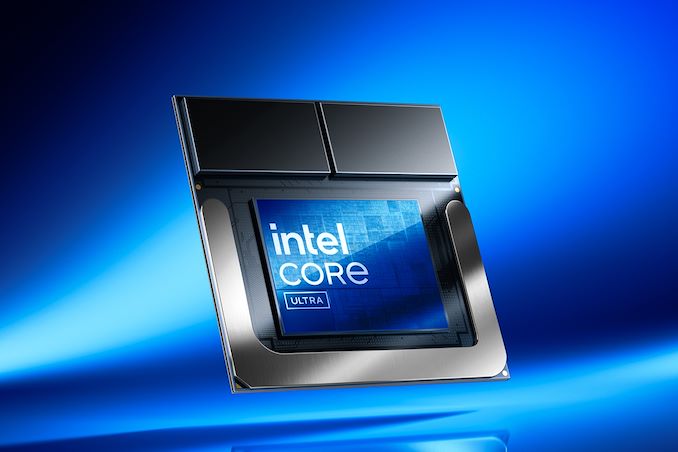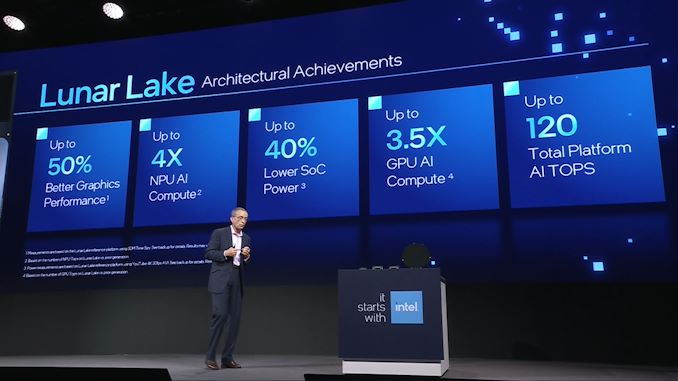Intel to Launch "Lunar Lake" Core Ultra Chips on September 3rd
by Ryan Smith on July 31, 2024 8:00 AM EST- Posted in
- CPUs
- Intel
- Lunar Lake
- Core Ultra
- Lion Cove
- IFA 2024

Intel’s next-generation Core Ultra laptop chips finally have a launch date: September 3rd.
Codenamed Lunar Lake, Intel has been touting the chips for nearly a year now. Most recently, Intel offered the press a deep dive briefing on the chips and their underlying architectures at Computex back in June, along with a public preview during the company’s Computex keynote. At the time Intel was preparing for Q3’2024 launch, and that window has finally been narrowed down to a single date – September 3rd – when Intel will be hosting their Lunar Lake launch event ahead of IFA.
Intel’s second stab at a high volume chiplet-based processor for laptop users, Lunar Lake is aimed particularly at ultrabooks and other low-power mobile devices, with Intel looking to wrestle back the title of the most efficient PC laptop SoC. Lunar Lake is significant in this respect as Intel has never previously developed a whole chip architecture specifically for low power mobile devices before – it’s always been a scaled-down version of a wider-range architecture, such as the current Meteor Lake (Core Ultra 100 series). Consequently, Intel has been touting that they’ve made some serious efficiency advancements with their highly targeted chip, which they believe will vault them over the competition.
All told, Lunar Lake is slated to bring a significant series of updates to Intel’s chip architectures and chip design strategies. Of particular interest is the switch to on-package LPDDR5X memory, which is a first for a high-volume Core chip. As well, Lunar Lake incorporates updated versions of virtually every one of Intel’s architecture, from the CPU P and E cores – Lion Cove and Skymont respectively – to the Xe2 GPU and 4th generation NPU (aptly named NPU 4). And, in a scandalous twist, both of the chiplets/tiles on the CPU are being made by TSMC. Intel isn’t providing any of the active silicon for the chip – though they are providing the Foveros packaging needed to put it together.
| Intel CPU Architecture Generations | |||||
| Alder/Raptor Lake | Meteor Lake |
Lunar Lake |
Arrow Lake |
Panther Lake |
|
| P-Core Architecture | Golden Cove/ Raptor Cove |
Redwood Cove | Lion Cove | Lion Cove | Cougar Cove? |
| E-Core Architecture | Gracemont | Crestmont | Skymont | Crestmont? | Darkmont? |
| GPU Architecture | Xe-LP | Xe-LPG | Xe2 | Xe2? | ? |
| NPU Architecture | N/A | NPU 3720 | NPU 4 | ? | ? |
| Active Tiles | 1 (Monolithic) | 4 | 2 | 4? | ? |
| Manufacturing Processes | Intel 7 | Intel 4 + TSMC N6 + TSMC N5 | TSMC N3B + TSMC N6 | Intel 20A + More | Intel 18A |
| Segment | Mobile + Desktop | Mobile | LP Mobile | HP Mobile + Desktop | Mobile? |
| Release Date (OEM) | Q4'2021 | Q4'2023 | Q3'2024 | Q4'2024 | 2025 |
Suffice it to say, no matter what happens, Lunar Lake and the Core Ultra 200 series should prove to be an interesting launch.
It’s worth noting, however, that while Intel’s announcement of their livestreamed event is being labeled a “launch event” by the company, the brief reveal doesn’t make any claims about on-the-shelves availability. September 3rd is a Tuesday (and the day after a US holiday), which isn’t a typical launch date for new laptops (for reference, the lightly stocked Meteor Lake launch was a Thursday). So Intel’s launch event may prove to be more of a soft launch for Lunar Lake; we’ll have to see how things pan out in the coming weeks.
Source: Intel Newsroom











17 Comments
View All Comments
James5mith - Wednesday, July 31, 2024 - link
"Lunar Lake is significant in this respect as Intel has never previously developed a whole chip architecture specifically for low power mobile devices before..."I mean, you know that's not true, right?
The Core architecture started as a mobile-first design that was wildly more efficient than the existing Pentium4 designs it ultimately replaced.
meacupla - Wednesday, July 31, 2024 - link
You are partially correct.While Core was based off of Pentium-M, Pentium-M is based off of i686 (Pentium Pro, P6) and it's an older design than netburst.
Ryan Smith - Wednesday, July 31, 2024 - link
More to the point, Pentium-M as a platform never aimed this low. Thin & light 15 Watt laptops weren't a thing in 2003, in part because half of what we take for granted now was still a discrete controller at the time.Lunar Lake scratches a very, very specific (one might say fruit-induced) itch at Intel for low-power mobile devices. If anything the closer analogy is Lakefield, but that was more of an experiment than a high-volume product that is getting Intel's full attention. Intel hasn't offered a mainstream product quite like this before, which is one of the reasons it's so notable.
Blastdoor - Wednesday, July 31, 2024 - link
'fruit-induced,' indeed. This looks like it was designed for a MacBook Air.If Intel had launched something like this in 2020 (albeit on TSMC N5), maybe Apple would still be a customer.
André - Wednesday, July 31, 2024 - link
Banias aka Pentium-M derived from the Tualatin Pentium III core.Kevin G - Wednesday, July 31, 2024 - link
I would've gone with Atom as a better example, though it was also found in low end desktops and a slew of embedded products.PeachNCream - Thursday, August 1, 2024 - link
Yeah Atom. There were lots of Atom CPUs long with various later generation Celeron n and Pentium n series chips that make this sort of article misleading Thanks to people in the comments section for fact checking at least.sharath.naik - Wednesday, July 31, 2024 - link
This is more like AMD launches. Paper only, with very little availability at high prices. This is because they still need to sell their 7 NM chips. Unlike before where Intel used to upgrade their manufacturing process on the same machines to a smaller node, This time they will need to replace a lot of expensive machines over a long period of time. They can not make their entire manufacturing sit idle while selling these built by TSMC. So they will throttle it hard, only on 1500$+ laptops for a nearly a year. Just like how AMD has been, atleast AMD is staying on the same node so their transition should be more immediate.whatthe123 - Wednesday, July 31, 2024 - link
They already moved on to i4/tsmc/20a for production. their last gen inventory is being sold simultaneously by rebranding into different SKUs. Both Lunar and Arrow are heavily reliant on TSMC, they have no reason to keep inventory low but good reason to keep production flowing so that they can maintain steady wafer allocation at TSMC.do_not_arrest - Wednesday, July 31, 2024 - link
This is where you are wrong. Intel has a HUGE amount of fab capacity sitting idle. This is why their Manuf. business is reporting huge losses every quarter. On top of that, they continue to build even more capacity in the hopes of getting foundry customers. On top of THAT, they continue to design and build chips using TSMC processes, which cannot help the capacity problem. Honestly none of their strategy really makes sense to me, unless they do the obvious that they seem to deny over and over again....